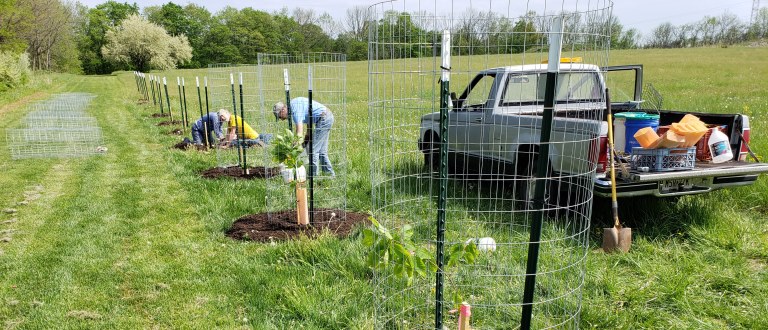The State We're In
Helping American chestnut trees recover from blight
“Chestnuts roasting on an open fire” is an American tradition, but the tradition actually dates back to prehistoric times. Roasting chestnuts is a big part of Italian holidays, and chestnuts are an important food crop in Asia and southern Europe.
The chestnuts we roast these days don’t come from our native American chestnut trees that once numbered in the billions and dominated forests throughout the eastern United States. Today our roasted chestnuts are Asian varieties.
For thousands of years, the native American chestnut (Castanea dentata) was one of the most important forest trees. Each fall, the tree’s sweet nuts would blanket forest floors, providing a bounty for critters and humans alike. Strong, rot-resistant chestnut wood was a prized building material.
But in the late 1800s, a bark fungus was accidentally introduced into North America on imported Asiatic chestnut trees. American chestnuts had little resistance, and the resulting blight – first discovered in 1904 in New York City – quickly spread.
Within 50 to 60 years, three to four billion American chestnut trees died. Although a small percentage of American chestnut trees survived the blight, the great chestnut forests that had existed for millennia were gone.
“The blight was one of the first ecological tragedies to hit this continent,” said Rex Parker, a member of the Hopewell Township Environmental Commission, which is leading an effort to restore American chestnuts in Central Jersey.
The Hopewell Environmental Commission has teamed up with the American Chestnut Foundation and several New Jersey nonprofits to plant new chestnut trees on public land.
Last spring, Hopewell Township and the Friends of Hopewell Valley Open Space planted 170 specially chosen nuts in protective tubes within a deer-fenced section of the Fiddlers Creek Preserve. “The nuts we planted came from naturally resistant wild parent trees,” explained Parker. “We’re hoping they also have some resistance.”
A dozen American chestnut seedlings were planted at the township’s Woolsey Park, and more were planted at nearby preserves in partnership with the D&R Greenway Land Trust, The Watershed Institute and Sourlands Conservancy. Hopewell Environmental Commission member Mike Aucott initiated the chestnut planting project and directed the plantings.
Of the chestnuts planted at the Fiddlers Creek Preserve, about 40 percent germinated and survived the first growing season. “We’ll go back this coming spring and do another similar planting,” said Parker.
The Hopewell Township plantings are the latest of several efforts across this state we’re in to grow chestnut trees – either from native American chestnuts with natural blight immunity, or hybrids created by breeding American chestnuts with Asian varieties.
Among the previous plantings were experimental plots on Schooley’s Mountain in Morris County, in Basking Ridge in Somerset County and in Tenafly, Bergen County.
According to Stephen Hoy of the American Chestnut Foundation, work is continuing on a long-term project to create the best hybrid chestnut with the natural characteristics of American chestnuts and the blight resistance of Asian varieties.
The effort started in 1983 with the idea that six generations of chestnut trees would be needed to create the best genetic lines. Currently, the fifth generation is being grown on a 10-acre orchard at Penn State University.
Hoy, who runs the orchard, said young trees are tested for blight resistance by inoculating them with the fungus. Those that survive two rounds of fungus – first a small amount, then a much larger amount the following year – are allowed to mature and are bred with other survivors.
Whenever possible, said Hoy, the Chestnut Foundation will also breed trees in the orchard with wild trees that survived the blight. From time to time, he noted, hikers discover mature American chestnut trees previously unknown to the foundation.
“We have materials on our website that tell people what to look for,” said Hoy. “If they come across a tree that may be an American chestnut, we ask them to record the longitude and latitude and send us a leaf and twig sample.”
Additional hope for American chestnuts may come from gene splicing. Scientists at the State University of New York (SUNY) in Syracuse are experimenting with splicing DNA from wheat into the DNA of chestnut trees to introduce an enzyme that provides resistance to the blight fungus. But regulatory approval from the federal government will be needed to distribute these “transgenic” chestnut trees outside SUNY.
With scientific advances and a bit of luck, someday our forests may again be filled with mighty American chestnut trees!
To learn more about American chestnut trees and how to identify them, visit the American Chestnut Foundation at www.acf.org/.
And for more information about preserving New Jersey’s land and natural resources, visit the New Jersey Conservation Foundation website at www.njconservation.org or contact me at info@njconservation.org.
About the Authors
Alison Mitchell
Co-Executive Director
John S. Watson, Jr.
Co-Executive Director
Tom Gilbert
Co-Executive Director, 2022-2023
Michele S. Byers
Executive Director, 1999-2021
View their full bios here.
Filter
Get The Latest News
From The Garden State
In the
News

